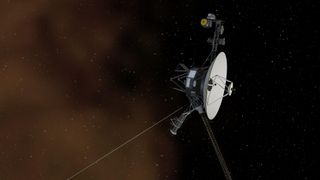NASA's twin Voyager probes are nearly 45 — and facing some hard decisions
It's the twilight years for the two NASA workhorses, but they're not ready to give up quite yet.

On August 20, 1977, NASA's Voyager 2 spacecraft launched to space. Its twin, Voyager 1, launched 16 days later. Today, they are not only the most distant man-made objects — at 12 billion and 14.5 billion miles (19.3 billion and 23.3 billion kilometers) away from Earth, respectively — but also NASA's longest-operating mission, continuing to send back data from their interstellar journeys toward the edge of the solar system as they approach their 45th birthdays.
But each Voyager spacecraft is powered by a finite nuclear energy source, and both sources are dwindling to dangerously low levels. Each spacecraft carries a store of the radioactive isotope plutonium-238; as the isotope decays, it releases energy that is converted into electricity by three radioisotope thermoelectric generators (RTGs). At launch, the RTGs provided each spacecraft with 450 watts of power. Now, they're producing less than half that amount and their electrical output is decaying by four watts each year.
"It takes about 200 watts, approximately, to run the transmitter on the spacecraft, to be able to send signals back to Earth, and we're at a power level currently where we only have about five to six watts of power margin on each spacecraft," Voyager Interstellar Mission project manager Suzanne Dodd, who also serves as the director for the Interplanetary Network Directorate at NASA's Jet Propulsion Laboratory (JPL) in California, told Space.com.
Related: 40 photos from NASA's epic 'grand tour' mission
The show isn't over yet, though. The Voyager teams have been strategically conserving power by turning off certain subsystems on both spacecraft, such as certain heaters, allowing others to function longer.
Miraculously, the remaining science instruments are so far performing well even in the cold temperatures. "It's great that we get data far beyond what we thought we could as far as operating the instruments cold," Dodd said.
Between the anniversaries of each spacecraft's launch this summer, the Voyager instrument teams will hold a meeting to discuss their recent results. The pooled data becomes the foundation for a new model that will guide future plans for both spacecraft, including any instrument shut-downs. With conservation methods, Dodd estimates that the spacecraft could operate for another five years, if their operation depended solely on power. "And if we got really lucky, maybe doing some operating below some thresholds, we might be able to go out to the 2030s," she said.
Get the Space.com Newsletter
Breaking space news, the latest updates on rocket launches, skywatching events and more!
But the advanced age of the spacecraft poses another problem: general failure of hardware and software. For instance, just a few months ago, Voyager 1's attitude articulation and control system (AACS), which orients the spacecraft and its communications antenna, began sending bad telemetry data back to Earth. That said, mission personnel know that the AACS is actually operating just fine because the signal from its antenna has remained stable — it just seems to be confused about its positioning.
"We can command the spacecraft and the spacecraft can send back the science data to us, so it's really operating as normal," Dodd said. "It's just this one computer system can't tell us that it's operating as normal."
Such anomalies are expected to pop up as both Voyagers age, and a glitch could ultimately lead to losing a spacecraft, even if it still has power. But however long Voyager 1 and 2 continue to operate, the Voyager mission is already a massive success. The original mission was to perform flybys of the solar system's gas planets and their moons and beam back data to Earth — tasks that both spacecraft had completed by 1989.
Then the secondary Voyager Interstellar Mission was initiated, tasking the Voyager spacecraft with obtaining information about the mysteries of space beyond the sun's influence. "How do things change as you go further and further away from the sun?" Dodd said. "And how does the magnetic field interaction with interstellar space change as you go further and further out? How does plasma density change as we go further and further out?"
There's only one way to answer those questions, she noted. "The key here is to keep the spacecraft operating and returning data as long as possible."
Follow Stefanie Waldek on Twitter @StefanieWaldek. Follow us on Twitter @Spacedotcom and on Facebook.
Join our Space Forums to keep talking space on the latest missions, night sky and more! And if you have a news tip, correction or comment, let us know at: community@space.com.

Space.com contributing writer Stefanie Waldek is a self-taught space nerd and aviation geek who is passionate about all things spaceflight and astronomy. With a background in travel and design journalism, as well as a Bachelor of Arts degree from New York University, she specializes in the budding space tourism industry and Earth-based astrotourism. In her free time, you can find her watching rocket launches or looking up at the stars, wondering what is out there. Learn more about her work at www.stefaniewaldek.com.
